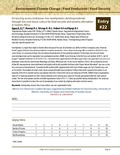Enhancing farmers’ access to disease-free sweetpotato planting materials through low cost tissue culture for food security and poverty alleviation in Eastern Africa.

View/
Date
2014Author
Ogero, S K
Mwangi, M
Gitonga, NM
Ombori, O
Ngugi, M
Metadata
Show full item recordAbstract
Sweetpotato is a major food staple in Eastern Africa because of its ease of cultivation and ability to thrive in marginal areas. However, limited supply of disease-free planting materials constrains production. Tissue culture technology offers a solution to this but it is very costly. Hence, it is necessary to have low cost options for production of clean planting materials. In this study, two low cost media were developed and used to regenerate two sweetpotato varieties, KEMB 36 and Tainung. In the first low cost medium (LCM 1), 2g/l of Easygro® vegetative fertilizer (27:10:16 (N: P: K) microelements) supplemented with table sugar (30g/l) and agar (9g/l) was used as an alternative source for the conventional Murashige and Skoog (MS) basal salts. In the second medium (LCM 2), the conventional sources of four MS macronutrients were substituted individually with locally available fertilizers while Stanes Iodized Microfood® was used as the low cost source of micronutrients. Conventional MS medium (CM) supplemented with 30g/l of table sugar and 3g/l of gelrite was used
as the control. The numbers of nodes, roots, leaves and plant height were recorded at 14 days interval for a period of six weeks. A cost reduction of 96.9% in nutrient sources was realized with LCM 1 while LCM 2 led to cost reduction of 94.4%. KEMB 36 had a regeneration index of 7.8 nodes per plantlet on LCM 2 during initiation while Tainung had a mean of 3.8 nodes per plantlet after the sixth week of culture. The two sweet potato varieties recorded regeneration indices of 3.3-7.1 nodes per plantlet during multiplication. This study has shown that it is possible to reduce the cost of sweetpotato tissue culture by adopting alternative nutrient sources.
